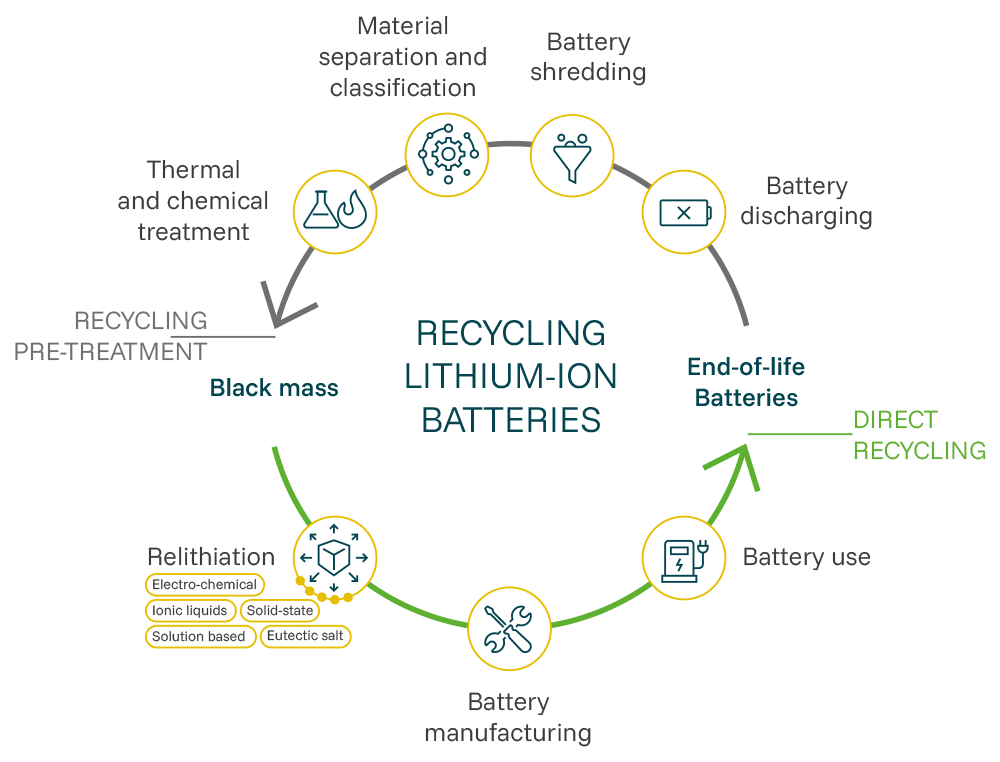Key drivers of our initiative
>40 million EVs expected on the EU’s roads by 2030
The EU is doubling down on transport electrification which is set to quadruple by 2040 to decarbonise the sector.
1% EU’s share of the global key battery raw materials production
EU is facing structural challenges.
70% (by weight) of Li-based batteries must be recycled by 2030
According to the EU Battery Regulation adopted in July 2023.
25% recycled CRMs available on the EU market by 2030.
According to the Critical Raw Materials Act [CRMA], adopted in May 2024.
≈ 1.3 TWh combined capacity expected by 2030
Increasing demand for battery materials, notably at components level – cathode & anode.
In the EU’s quest to become a climate-neutral economy by 2050, batteries stand as one of the key technologies that will support this transition and the continent’s industrial future. By providing efficient energy storage solutions, batteries have the potential to mitigate the intermittence of renewables and to cut the GHG emissions of the transport sector, accountable in 2022 for 29 % of all EU emissions.
Despite faltering economies and material shortages, more than 40 million electric vehicles (EVs) are expected on the EU’s roads by 2030. With mass electrification of transport, there will be an important demand for batteries and the materials they are made from. Despite an incentivising regulatory context at EU level, in 2023 Europe was home to only 1% of the production of key battery raw materials. European carmakers and battery cell producers are already fret about volatile prices and limited supplies of cathode and anode materials. But with EV fleet number growing on the EU’s roads, the volumes of End-of-life (EoL) batteries will considerably increase in the near future. And so will the pressure to recycle closer to home. Additionally, from July 2024, the carbon footprint of batteries in EVs sold in the EU will need to be declared. New rules on carbon footprint come accompanied by new recycling targets and due diligence checks, according to the the EU battery Regulation.
- REPowerEU
- Critical Raw Materials Act
- EU battery Regulation
- Green Deal industrial plan (GDIP)
- Dashboard towards zero-emission vehicles
- European Commission’s 2040 Communication with regards to climate target and path to climate neutrality by 2050
- Roadmap on raw materials and recycling [Batteries Europe]
-
2025
-
2027
90% Ni
90% Co
50% Li -
2031
95% Ni
95% Co
80% Li
A circular supply chain for battery components
The way in which batteries are recycled today pose many problems. Some are labour-intensive, while others are energy-intensive or environmentally harmful. Current low efficiencies of these processes and high costs are due to poorly designed pre-treatment operations. Batteries are prematurely crushed or shredded, which complicates material separation in the next stages and overlooks the potential to reuse and repurpose the other components, such as cables and casing. This leads to additional separation steps and increased processing costs.
Addressed challenges by RESTORE
Current state-of-the-art (SoA) industrial processes for recycling lithium-ion batteries (LIBs) face significant challenges. These methods often produce black mass (BM) with considerable impurities, including aluminium, copper, iron and carbon particles. Additionally, anodic and cathodic materials get mixed, necessitating costly and environmentally harmful pyro or hydrometallurgical processes to separate them. The inefficiency of these processes results in the loss of valuable metals and requires substantial resources such as energy and chemicals.
RESTORE will address these challenges and establish new sustainable, cost-competitive integrated process es towards a zero-waste strategy. This initiative aims to enable the recovery of all battery materials at high purity, such as anodic and cathodic components, solvents and Li-salts in electrolytes, and other non-active materials (binders, separators, and other polymers), for reintegration into energy storage applications.

Current direct recycling process, including recycling pre-treatment and recycling steps, covering application of differente relithiation techniques.
Reduce the mixing of materials from the start, using intelligent and fast contactless sorting techniques to separate batteries based on their types and chemistries
Discharge small domestic batteries with low-cost, safe, and environmentally friendly solutions. While the discharging of EV battery packs is becoming more established on an industrial scale, small domestic batteries remain a challenge, posing risks such as fires to industrial operations.
Introducing innovative low cost and environmentally friendly processes for the fast and automated liberation of battery modules and cells from battery packs
Develop efficient, fast, and low-cost separation concepts for anodic, cathodic, and other components from the cell, using novel scalable techniques without the need for shredding or grinding the cell. This will maintain the purity of the materials for their repair and direct recycling or reuse in energy storage applications.
Improve the materials purity level from current industrial recycling lines where batteries are still shredded or ground. This requires new low-cost and environmentally friendly processes to separate anodic and cathodic materials with high purity from generated Black Mass (BM). These high-purity electrode materials can then be reinjected into existing battery production lines with minimal effort, avoiding complicated and costly full hydrometallurgical processes.
Utilise high-purity cathode material obtained through advanced pre-processing technologies for direct recycling routes, where recovered cathodic materials can be repaired and tailored directly to the desired specifications without the need for full separation of elements and reformulation of new cathodic precursors. This advanced pre-processing and direct recycling will not impede the second life of materials.
Bring the whole process towards a zero-waste and cradle-to-cradle concept by recovering, separating, purifying, and valorising all battery-related materials, including electrolyte, binders, separators, polymers, and metals.
Use safe, low-cost, industrially scalable, and environmentally friendly technologies based on process intensification principles for the processes addressed above.
